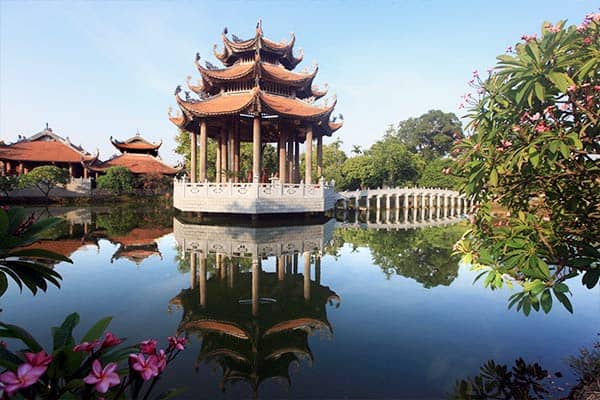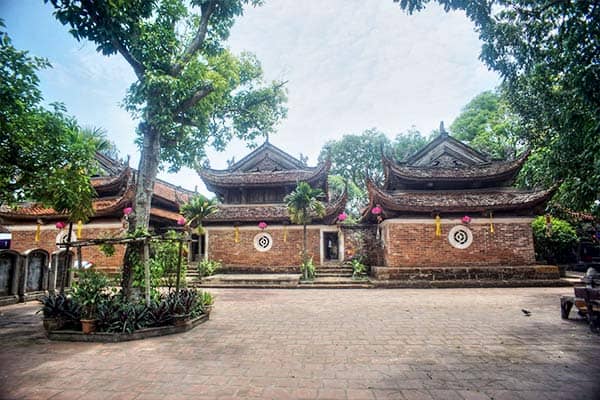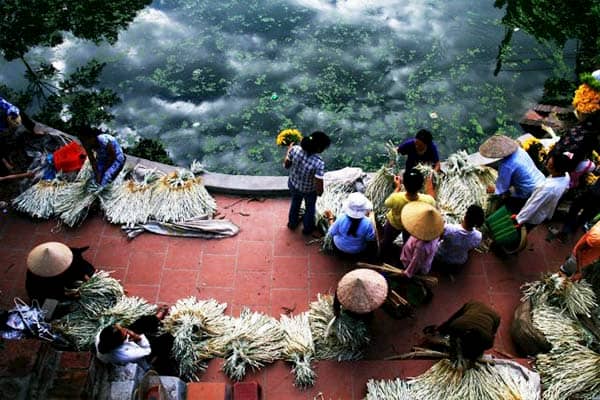THE SURROUNDINGS OF HANOI - NORTHERN VIETNAM
THE AUTHENTICITY AND SERENITY TYPICAL OF NORTHERN VIETNAM
In Hanoi, the capital of Vietnam, there is no shortage of activities and places to visit, quite the contrary. However, if you move a little further away, you will notice that there are also many interesting places to discover around Hanoi in northern Vietnam.
Villages around Hanoi
First of all, several typical villages are easily accessible from the capital, while allowing you to change the setting and move from the city's permanent activity to calm and tranquility. Visiting these villages will allow you to diversify your trip to Vietnam.
Duong Lam
Duong Lam village is an excellent example of a typical village in northern Vietnam. Located about 50 km from Hanoi, this village, classified as a national heritage site in 2006, houses about 950 traditional houses, some of which were built several centuries ago, up to the 17th century. These houses are made with traditional materials such as bamboo, straw, clay,... Some also have traditional sculptures representing sacred figures (dragons,...) at the entrance.
On site, it is also possible to visit the Mia pagoda. Extremely quiet, like the village, this pagoda houses 287 religious statues, making it one of the most important pagodas in the country in this field despite its relatively small size. These statues are made of clay, wood or bronze.
Another characteristic of Duong Lam village: two kings of Vietnam were born in this village, which makes it even more interesting. They are Phung Hung (761-802) and Ngo Quyen (897-944). The village houses a temple dedicated to the first, and another dedicated to the second.
The village of Duong Lam is a perfect example of authenticity to discover Northern vietnam as it was years ago.

Pagoda of the village Nôm
Nôm
Like Duong Lam, Nôm is also a typical Vietnamese village that has kept its authenticity despite the weather.
The village is 200 years old but is very well preserved, and calm and peace prevails. One reason is that few tourists visit this village, which is only about 40 km from Hanoi.
It is thus possible to stroll around and enjoy the relaxing setting, with the presence of many trees that accompany traditional houses, which are still in very good condition as well as the historical remains.
Your walk will take you to a stone bridge that crosses the Nguyet Duc river that flows around the village. This bridge, considered the oldest of its type in the North, is nicknamed the Bridge of the Nine Dragons by the inhabitants. This nickname is linked to the dragon sculptures on each of the nine pillars.
The Nôm pagoda is another important element of the village. It has a certain notoriety throughout the country because it shelters no less than 122 clay statues that could go back thousands of years according to some experts, and which represent different emotions of the human being. These statues have withstood time and several floods, with virtually no impact on their condition, unlike the foundations around them, which have been rebuilt many times.
The village has other assets such as the Tam Giang temple or the Nôm market, which is more lively on the days ending with numbers 1, 4, 6 and 9 of the lunar calendar.
Pagodas around Hanoi
The villages mentioned in this article each have a large pagoda, but there are also interesting pagodas in the surroundings of Hanoi independently.
The Thay Pagoda
Thay Pagoda (also known as the Master's Pagoda or the Celestial Blessing Pagoda) is located at the foot of Sai Son Mountain, about 30 km from Hanoi and was built in the 11th century. It is composed of 3 parts: the Ha pagoda (for offerings and ceremonies), the Trung pagoda (whose role is to pay tribute to Buddha) and the Thuong pagoda (in memory of the monk Tu Dao Hanh, founder of puppet shows on the water). A statue dedicated to Tu Dao Hanh is also present on the spot, as is another dedicated this time to King Ly Nhan Tong. The Nhat Tien and Nguyen Tien bridges, dating from 1602, frame the pagoda. Opposite it is the Long Tri Lake with a pavilion on stilts which represents the oldest puppet theatre on the water (17th century).
This pagoda is also famous for the celebration it is the subject of from the 5th to the 7th day of the third lunar month. The Thay Pagoda festival takes place in several stages, all to music and allowing participants to enjoy traditional games, puppet shows on the water and offerings. This celebration is therefore an extremely enriching cultural and human experience for visitors who visit it.
Tay Phuong Pagoda
10 km from Thay Pagoda is Tay Phuong Pagoda, which has a remarkable architecture and is the second oldest pagoda in Vietnam.
This pagoda was originally built during the 7th century but has undergone many renovations and changes throughout history, notably in 1554, 1660, 1794 and 1995. It is accessed by 239 stone steps.
The pagoda is composed of three parallel parts. These are the upper temple, the middle temple and the lower temple. Each part has two floors and a sculpted roof with motifs representing sacred figures (dragons, phoenix,...) and flowers.
The pagoda also houses a collection of 62 nationally recognized wooden statues. The statues represent different states of mind through which human beings pass. Among them are 18 "Arhat" statues on a human scale, which have allowed Tay Phuong Pagoda to benefit from the title of "pagoda with the most representative Arhats of Vietnam's 18th century sculpture art".
In addition to being an architectural masterpiece, this pagoda is a renowned place of worship that has an annual celebration, held on the 6th day of the 3rd lunar month. Many activities are on the agenda. This festival thus attracts not only pilgrims but also many visitors wishing to attend and participate in such an event.

Tay Phuong Pagoda
Craft villages
Several craft villages also exist around Hanoi.
Chuong
Located south of Hanoi, Chuong is a small village renowned for its conical hats, true symbols of Vietnamese culture, and the quality of these hats. These hats are now also present in some artistic events or fashion shows, while being of great interest to tourists, who are more and more willing to buy them and bring them back when they return.
The manufacture of a conical hat takes several steps, such as cutting bamboo stems or cutting latan leaves. This complex process thus represents a profession whose art is transmitted from generation to generation in Chuong.
Walking or cycling in Chuong village guarantees a moment of calm and serenity, in addition to being a very enriching experience.

Conical hats market in Chuong village
Bat
Trang
Bat Trang is a village located east of the capital and represents the most famous pottery village in Vietnam. Indeed the village is located in an area rich in clay, which allows it to produce a lot of pottery.
The majority of the pottery produced in Bat Trang is useful in everyday life as cups, plates, accessories,...
Visiting Bat Trang allows you to learn more about the manufacturing process of such objects, to exchange with the locals and also to try your hand at making objects.
Vac
30 km from Hanoi is the village of Vac, which owes its fame to various crafts but especially to the manufacture of bird cages. Once again, it is a profession that is passed on from generation to generation. The inhabitants of Vac also received several medals at exhibitions in Hanoi during the French colonization. The quality and elegance of the cages produced in Vac make it a renowned product throughout the country, and many cages are exported to other cities in the country but also internationally.
The process of making a cage is long, and the cages are different depending on the species of bird for which they are intended. The physiognomy or behaviour of the species are thus criteria taken into account and which influence the cage model.
The
collection of bird cages is becoming more and more frequent in Vietnam. Whether
or not it is the case for visitors, discovering this craft village is always a
very positive experience.



